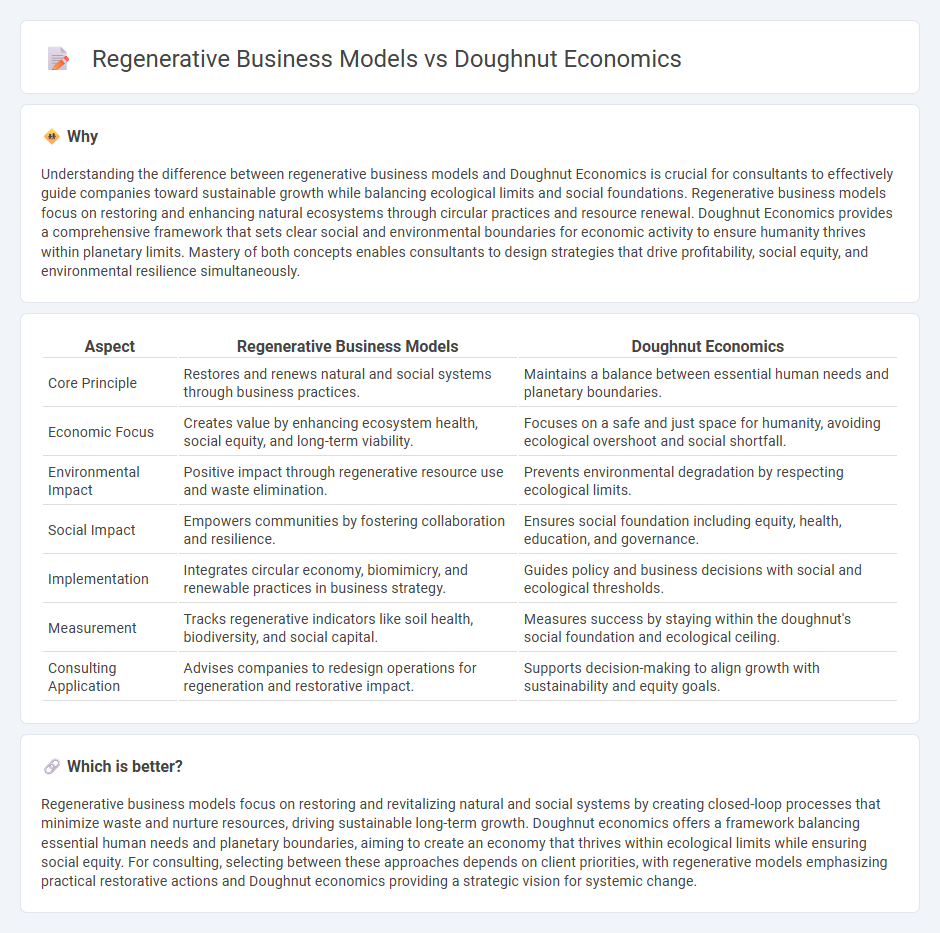
Regenerative business models prioritize restoring ecosystems and enhancing social equity while maintaining profitability, contrasting with Doughnut economics, which emphasizes operating within planetary boundaries and social foundations to achieve sustainable development. Both frameworks challenge traditional linear models by integrating environmental and social factors into economic decision-making. Explore how these approaches redefine business sustainability for a resilient future.
Why it is important
Understanding the difference between regenerative business models and Doughnut Economics is crucial for consultants to effectively guide companies toward sustainable growth while balancing ecological limits and social foundations. Regenerative business models focus on restoring and enhancing natural ecosystems through circular practices and resource renewal. Doughnut Economics provides a comprehensive framework that sets clear social and environmental boundaries for economic activity to ensure humanity thrives within planetary limits. Mastery of both concepts enables consultants to design strategies that drive profitability, social equity, and environmental resilience simultaneously.
Comparison Table
| Aspect | Regenerative Business Models | Doughnut Economics |
|---|---|---|
| Core Principle | Restores and renews natural and social systems through business practices. | Maintains a balance between essential human needs and planetary boundaries. |
| Economic Focus | Creates value by enhancing ecosystem health, social equity, and long-term viability. | Focuses on a safe and just space for humanity, avoiding ecological overshoot and social shortfall. |
| Environmental Impact | Positive impact through regenerative resource use and waste elimination. | Prevents environmental degradation by respecting ecological limits. |
| Social Impact | Empowers communities by fostering collaboration and resilience. | Ensures social foundation including equity, health, education, and governance. |
| Implementation | Integrates circular economy, biomimicry, and renewable practices in business strategy. | Guides policy and business decisions with social and ecological thresholds. |
| Measurement | Tracks regenerative indicators like soil health, biodiversity, and social capital. | Measures success by staying within the doughnut's social foundation and ecological ceiling. |
| Consulting Application | Advises companies to redesign operations for regeneration and restorative impact. | Supports decision-making to align growth with sustainability and equity goals. |
Which is better?
Regenerative business models focus on restoring and revitalizing natural and social systems by creating closed-loop processes that minimize waste and nurture resources, driving sustainable long-term growth. Doughnut economics offers a framework balancing essential human needs and planetary boundaries, aiming to create an economy that thrives within ecological limits while ensuring social equity. For consulting, selecting between these approaches depends on client priorities, with regenerative models emphasizing practical restorative actions and Doughnut economics providing a strategic vision for systemic change.
Connection
Regenerative business models align with Doughnut economics by prioritizing environmental sustainability and social equity within economic activities. Both frameworks emphasize operating within planetary boundaries while meeting human needs, creating a balanced approach for long-term resilience. This synergy guides consulting strategies that help organizations innovate responsibly and foster systemic positive impact.
Key Terms
Circular Economy
Doughnut Economics emphasizes balancing social foundations and ecological ceilings to create sustainable systems, while regenerative business models prioritize restorative practices that renew resources and ecosystems within the Circular Economy framework. Both approaches seek to minimize waste and maximize resource efficiency through closed-loop processes, promoting resilience and long-term environmental health. Explore how integrating these models can drive innovation and sustainability in modern business.
Systems Thinking
Doughnut economics offers a framework that balances human needs with planetary boundaries through a visual model emphasizing social foundations and ecological ceilings. Regenerative business models integrate systems thinking by designing operations that restore ecosystems and enhance community well-being, moving beyond sustainability to net positive impact. Explore how these approaches interconnect to drive holistic economic transformation.
Social Foundation
Doughnut economics emphasizes maintaining a social foundation by ensuring basic human needs like health, education, and equity are met without exceeding ecological limits. Regenerative business models prioritize creating positive social impact by restoring community well-being and fostering resilient ecosystems through circular practices and inclusive governance. Explore how integrating doughnut economics with regenerative business strategies can drive sustainable development and social equity.
Source and External Links
Doughnut (economic model) - Wikipedia - The Doughnut Economic model, created by Kate Raworth, is a visual framework combining planetary boundaries and social foundations to define a safe and just space for humanity where essential needs are met without exceeding ecological limits.
Doughnut Economics by Kate Raworth - Chelsea Green Publishing - Kate Raworth's book introduces Doughnut Economics as a new compass for economic thinking that addresses 21st century social and ecological challenges by focusing on thriving rather than growth alone.
About Doughnut Economics | DEAL - The Doughnut concept offers a vision for humanity to thrive sustainably and justly, influencing global discussions and practical applications in education, business, and governance worldwide.
 dowidth.com
dowidth.com